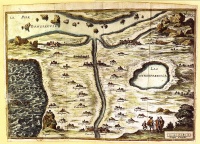The Dictionary of Imaginary Places
From The Art and Popular Culture Encyclopedia
|
Ignorance: "Chaîne de montagnes dans le royaume de la sagesse"; Imaginaire: "Pays insulaire non localisé, où les filles ne sont pas admises, et où l'on peut arriver de trois façons différentes : en s'endormant, en tombant de son berceau, ou en y étant transporté par Peter Pan." |

|
Related e |
|
Featured: |
The Dictionary of Imaginary Places (1980, 1987, 1999) is a book written by Alberto Manguel and Gianni Guadalupi. It takes the form of a catalogue of fantasy lands, islands, cities, and other locations from world literature—"a Baedecker or traveller's guide...a nineteenth-century gazetteer" for mental travelling.
Originally published in 1980 and expanded in 1987 and 1999, the Dictionary covers the terrains that readers of literature would expect—Ruritania and Shangri-La, Xanadu and Atlantis, L. Frank Baum's Oz, Lewis Carroll's Wonderland, Thomas More's Utopia, Edwin Abbott's Flatland, C. S. Lewis' Narnia, and the realms of Jonathan Swift and J. R. R. Tolkien; and also a vast host of other venues, created by authors ranging from Dylan Thomas to Cervantes to Edgar Rice Burroughs, from Carl Sandburg to Rabelais to Sir Arthur Conan Doyle. (Plus the Marx Brothers' Duck Soup, among other non-orthodox texts.)
To remain of manageable size, the Dictionary excludes places that are off the planet Earth (eliminating many science fiction locales), as well as "heavens and hells and places of the future," and literary pseudonyms for existing places, like the Yoknapatawpha County of William Faulkner or the Barsetshire of Anthony Trollope and Angela Thirkell. It compensates by covering a wide range of anonymous and obscure sources, and volumes of forgotten lore.
The book is widely noted for the number and excellence of its illustrations, by Graham Greenfield, and its maps and charts, by James Cook. Guadalupi and Manguel acknowledge Philip Grove's The Imaginary Voyage in Prose Fiction (1941), and Pierre Versins' Encyclopèdie de l'Utopie, des Voyages extraordinaires et de la Science-Fiction (1972), as precedents and inspirations.
References
- Cuddon, John Anthony. A Dictionary of Literary Terms and Literary Theory. London, Blackwell, 1998.
- Manguel, Alberto, and Gianni Guadalupi. The Dictionary of Imaginary Places. New York, Harcourt, Brace, Jovanovich, 1980, 1987, 1999.
- Wynar, Bohdan S. American Reference Books Annual, 1988. Westport, CT, Libraries Unlimited, 1988.
See also
- The League of Extraordinary Gentlemen
- Fictional universe
- Fictional country
- Tik-Tok of Oz
- Alberto Manguel
- A Traveler from Altruria
- The Fixed Period
- Arqtiq

